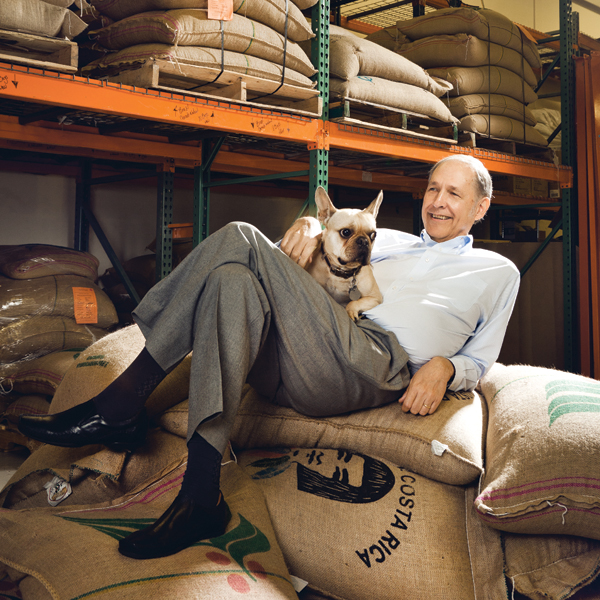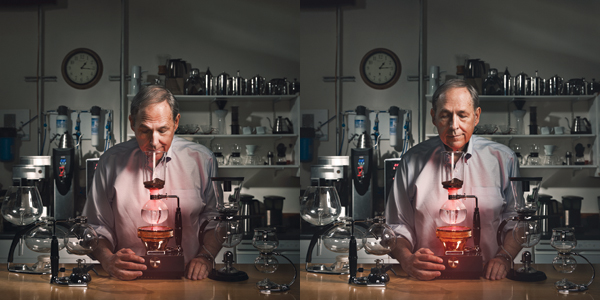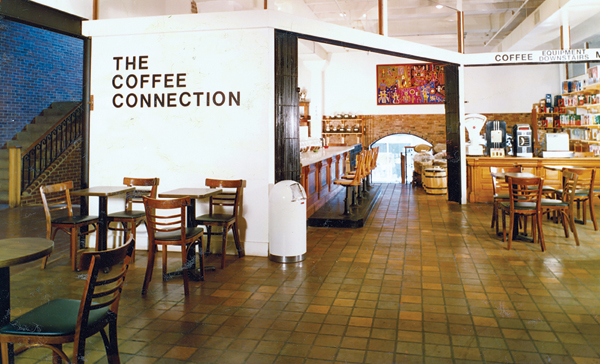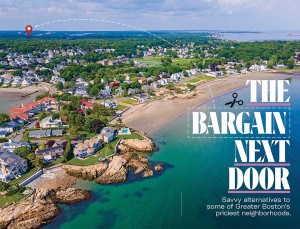George Howell Coffee: Back to the Grind
Nearly two decades after selling his iconic Coffee Connection chain to Starbucks, George Howell is about to attempt a comeback. Can the café visionary retake the coffee world, or has his time passed?

Photo by Miller Mobley
The sampling, or “cupping,” of coffee is an intricate process. Demonstrating it one recent morning, George Howell places a precisely measured layer of freshly ground beans on the bottom of a glass, then sniffs, shakes, and sniffs again. Boiling water is poured on the coffee, and Howell puts his nose up close and inhales deeply. Then, surgeon-like, he uses two spoons to remove any bean debris or foam that’s floated to the surface of the glass. Next comes the stir: A spoon is rapidly submerged three times in the glass to allow the aromas to escape. Howell leans over, putting his face up against the edge of the glass as he stirs. As I attempt the maneuver alongside him, I wind up splashing coffee on my nose. Howell, laughing, tells me I’ve been baptized.
That’s not much of a stretch, actually. At various times, Howell has been called an “idol,” a “god,” and the “high priest” of the coffee bean. “George has this almost mystical obsession with coffee flavor,” says Peter Giuliano of the Specialty Coffee Association of America. “It’s totally inspiring to coffee people. He has a transcendent passion about coffee, and a quasi-religious zeal.”
In 1975 Howell opened the Coffee Connection, the Harvard Square café that would become a national model for the gourmet coffee experience. His revolutionary idea was to source high-quality beans and roast them lightly, allowing subtle, more nuanced flavors to emerge, a huge contrast with the nearly burned roasts that dominated the day. Howell was also one of the first roasters to source beans not just from particular countries, but from individual farms—each with a unique flavor profile, or terroir, owing to factors such as soil quality, latitude, altitude, and annual rainfall. So instead of mixing beans to create, say, a Costa Rican blend, Howell purchased from single-estate farms to create distinct brews.
His café was also the birthplace of still another industry-altering innovation: the Frappuccino. The trademarked blend of espresso, milk, ice, and sugar debuted in 1992 and quickly reshaped Boston’s coffee-consumption habits, eventually becoming the driving force behind an aggressive expansion of the Coffee Connection chain, which by 1994 had 23 locations throughout the Northeast. The drink also attracted the attention of a Seattle coffee company with national aspirations. In 1994 Starbucks made the Coffee Connection its first acquisition, paying $23 million for the chain and the rights to the Frappuccino name.
It’s been nearly 20 years since Howell sold the Coffee Connection, yet he remains an influential figure in what has become a specialty-coffee movement in this country. In the late ’90s, Howell was hired by the United Nations to improve the quality of Brazilian coffee beans, which inspired him to create Cup of Excellence, an international development program that helped set up the direct trade of beans from small coffee farmers to roasters. And just a few years after the noncompete agreement he signed with Starbucks expired in 2001, he opened a roastery in Acton called Terroir Coffee.
These days Howell is a fixture on the coffee-lecture circuit (yes, there is such a thing), and continues to be very much the coffee innovator. For example, he incubated the software program ExtractMoJo, which has become an industry standard by helping baristas pour coffee with the precision of a nuclear physicist. “He’s this celebrity,” says Merry “Corky” White, a Boston University anthropology professor who is an expert on international coffee culture. “People all over the world know his name.”
That may be so, but spend time with Howell and you quickly get the impression that, as far as he’s concerned, not nearly enough of them do. While waiting for his noncompete agreement to expire, Howell was forced to watch from the sidelines as it was Starbucks, and not the Coffee Connection, that ignited the American coffee revolution. And many of those beans he was busy sourcing as part of his work with the UN wound up being bought by the generation of high-quality independent roasters and retailers who sprung up after that revolution—the companies that today are spoken of by the coffee cognoscenti in the same reverent tones that nearly 40 years ago were reserved for Howell’s pioneering chain of cafés.
So now, at age 68, George Howell is setting out to reconquer the coffee world. He’s certain that he’s got the solution to the problem with the industry these days—that it’s been hijacked by latte elitists with no appreciation for the simple, pure, “noble” drink that’s been the love of his life and the source of his fortune. These coffee snobs instead push fussy coffee-based beverages with complicated combinations of milk, sugar, and foam, Italian-sounding names, and high profit margins. With the Frappuccino, Howell may have set off the nation’s addiction to what are essentially coffee milkshakes, but he’s every bit the purist, disdainful of the espresso and “latte art” crazes, and convinced that boring old drip coffee is, as ever, the pinnacle of the form.
Howell is determined to put the coffee back at the forefront of the coffee shop, starting with a new flagship café here in Boston that will elevate the drink to its rightful place next to wine. He envisions regular tastings and cuppings, formal lessons in the flavor profiles of beans from the different regions of the planet, and, in general, a daily celebration of all things coffee. His aim is to make the drinking of your morning brew a “30-minute pleasure trip.” He sees his concept spreading across the country, location by strategic location. It’s a bold plan from a visionary coffee entrepreneur, but there are a few complications, chief among them the fact that it’s far from clear that anybody is really clamoring for yet another chain selling good coffee. With even McDonald’s elbowing its way into the “premium roast” game these days, it’s at least worth asking whether the market has become saturated. And even it if hasn’t, even if there is room for an innovative new concept, a lot of people close to Howell wonder whether he’s really the guy to lead the charge. In part, that’s because Howell has tried a comeback before. Nearly 10 years ago, he opened a restaurant and café in Lexington that wound up a costly failure. There are also questions about just how well Howell’s passion for unadorned drip coffee matches up with the tastes of the consumers who actually spend money in cafés. And finally, explains Howell’s friend Dan Cox, who is an industry analyst, there’s a concern that the coffee drinkers of today “don’t understand that you’re the old master. They really don’t care.”
Cox has expressed these reservations directly to his friend, but Howell is resolute. He’s changed the name of his company to George Howell Coffee, confident that his reputation and expertise will give him an advantage in the marketplace. This past February, he opened a tiny Newton café under that name, and is using it as a testing ground for his new concept. And not long after leading me through the intricacies of the coffee cupping, he was off again in search of a flagship location for his next coffee empire.

Howell demonstrates the siphon technique of brewing coffee, which he says produces the “clearest cups and delicate flavors” of the coffee bean. It’s one of many methods he hopes to use at his flagship café. / Photo by Miller Mobley
Howell looks a bit like the actor Chevy Chase. His sideburns are graying and his hair is thinning on top, and his teeth have a patina that comes from a lifetime of drinking coffee. On this September afternoon, as he prepares to conduct a cupping in the hip Brooklyn shop Marlow & Sons, he’s wearing a light khaki jacket and pants, with a button-down shirt the color of orange sherbet.
It’s Howell’s first-ever “road” cupping, a demonstration for the baristas at the shop, which has been serving coffee from Howell’s roastery for the past year. The event was arranged by members of his sales team, part of the effort to relaunch the roastery under the George Howell Coffee brand, but for Howell, it’s also a scouting mission. Marlow & Sons and its adjoining sister establishment, Diner, are, together, a restaurant, a bar, a coffee shop, and a dry-goods store that sell both grass-fed beef and $425 bespoke leather handbags with tags boasting that they were “handmade in NYC with the tanned hide of a cow we served here last fall.” The place, in other words, is representative of a new generation of coffee retailers, the sort that Howell expects to compete against with his new cafés.
Howell, who looks to have about four decades on the rest of the room, begins the tasting with a slide show about the provenance of today’s beans, which he sourced from several independent farms in Guatemala. Howell is big on slide shows, and his PowerPoints involve the sort of detail you find in an Al Gore presentation on the dangers of global warming. While he spends the next 45 minutes clicking through photos of volcanic cones, rows of coffee plants, and close-ups of “cherries”—the cranberry-looking fruit from which the coffee bean is extracted—the baristas remain silent. Howell at last clicks off the projector and walks to an orange table in the back of the room, where 40 glasses have been arranged for the cupping. The baristas, looking less than excited, join him, and Howell begins the tasting. For a few minutes, the only sounds are the clinking of spoons hitting glasses, a chorus of slurps, and subway trains rattling over the Williamsburg Bridge. The new rules of the coffee cupping, Howell explains later, dictate that people stay silent as they taste, in order to have a pure experience that doesn’t influence anyone else’s opinion. “I like a more informal approach,” he says.
Howell begins to prod the group, encouraging them to identify the flavors they detect in the coffees. “I don’t care if you taste rubber tires,” he says. “I want to hear from you.” Finally, the baristas begin to engage. Someone named Dillon Edwards, who looks a bit like Van Gogh in a blue painter’s jacket and a straw hat, tells Howell that he has plans to operate a pop-up coffee shop in the barber shop up the street. He’s been working with a gypsy roaster. Soon, everyone is discussing the subtle notes that reveal themselves in Howell’s coffees: currant, cashew, caramel, even hints of blueberry and strawberry. The baristas begin snapping Instagram photos of the table and uploading them to Twitter.
The growing similarities between the coffee and wine experiences are hard to miss—the ceremony of the tasting, the emphasis on flavor profiles from regions and even individual farms, the snobbery. None of this, of course, is lost on Howell, who at one point warns the baristas that “there’s a lot of pretense in this industry, but I have no doubt that your taste can be equal to that of professional cuppers”—and who later describes the plans for his new flagship café this way: “What we envision down the road is ultimately being like a wine store. You go to a really great wine store, they’ll have thousand-dollar bottles of wine, but they’ll also have great values. That’s where I want our company to go.” He also anticipates lots of seminars, cuppings, and tastings, the kinds of events that will make his place a center of coffee exploration and celebration rather than just another café.
“The Frappuccino,” George Howell says, “wasn’t my life goal.”
Raised in New Jersey, Howell moved with his family to Mexico City at age 13. In 1964 he landed at Yale, where he studied art history and modern French and Spanish literature, but soon found himself more taken with New York City’s jazz clubs. In 1967 he dropped out. That same year, he met his future wife, Laurie, and in 1968 the couple moved to Berkeley, California, where Howell, working as an art dealer, staged exhibitions of swirling, psychedelic Huichol Indian yarn paintings.
At the time, Berkeley was just beginning to establish its reputation as California’s “gourmet ghetto,” a development that was aided in part by the Dutch entrepreneur Alfred Peet, who was attracting throngs to his café by selling freshly roasted beans. In time, the Bay Area café culture started to thrive, and shops became havens for young, turtleneck-clad bohemians. Eventually Howell decided to move back East, and, having developed a taste for high-quality brews, packed up his pregnant wife, their two children, and several bags of beans. (Howell now has six children.) As the family drove across the country, he would insist on using his own grinder and French press at diners, asking the waitresses to pour him some hot water so he could brew his own coffee, lest he be forced to drink the place’s sludge.
In 1974 Howell arrived in Boston and found himself in a coffee wasteland. The post-war convenience of instant brands like Maxwell House and Taster’s Choice had dulled American taste buds, and coffee was considered nothing more than a cheap commodity (it remains the second-most-traded commodity on the planet, after petroleum). Dunkin’ Donuts was selling its own brew, of course, but most of its sales came from baked goods. No one was providing quality, freshly roasted coffee to the city of Boston.
Howell’s motivation for moving here was to get a foothold in the art world. And in his newly developed coffee passion, he saw an opportunity to do just that. “Creating the Coffee Connection in Harvard Square was a way of putting up an art gallery and doing the coffee simultaneously,” he recalls. “Only we didn’t know anything about coffee.”
In 1975 Howell opened the Coffee Connection in the Garage, sourcing his beans from Zabar’s in New York while waiting on the delivery of his own coffee roaster. The shop was an immediate success. “I did not drink much coffee prior to becoming almost infatuated with Coffee Connection,” says Gus Rancatore, who has owned Toscanini’s ice cream in Cambridge for three decades. “I have immensely fond memories of that place. It was the best people-watching spot in the history of Cambridge. I think half of what I know is because of George—a lot of what I tried to reproduce in retailing was because of that store.”

Photo courtesy of George Howell
In the next decade, the Coffee Connection opened locations in Faneuil Hall, Newton Centre, and Beacon Hill. Several more had opened by 1988, the year Howell flew to Seattle to scout out a coffee chain that had transfixed that city. The three owners of Starbucks had opened their first shop in Pike Place Market in 1971, sourcing their beans directly from Alfred Peet. Their devoted customer base eventually attracted the attention of Howard Schultz, a New York–based housewares executive who’d noticed that the shop was selling an inordinate number of his drip coffeemakers. After trying Starbucks coffee for himself, Schultz realized he’d found a game-changer. He convinced the owners to hire him, and eventually became the company’s chairman, president, and CEO.
“Howard Schultz was telling us he was going to take over the world,” Howell recalls. “He said that right from the start. He had a national strategy, while we had regional ones.” So as Starbucks moved East, Howell prepared himself for the arrival of the “wave of darkness.” (Howell, legendary for his lightly roasted coffees, generally despises dark roasts, and has been known to refer to Schultz’s company as “Charbucks.”)
“George was terrified that they were going to completely put us out of business,” recalls Andrew Frank, Howell’s marketing director at the time. “We repositioned our cafés, relaunched our menus, and prepared for the dark roasts that were coming.” As part of the defensive positioning, Howell began looking for ways to make up for the loss of drip-coffee sales during the summer months. That led him to investigate the new West Coast trend of selling iced cappuccino drinks. Frank began experimenting with recipes, finally settling on a creamy blend of espresso, milk, ice, and sugar that was mixed in soft-serve ice cream machines. Frank also came up with the name, a play on the frappe. In 1992 the Frappuccino was born.
Howell began an aggressive expansion to fend off Starbucks. He brought on a board, raised venture capital, and doubled the number of Coffee Connection stores in one year. By the spring of 1994, the chain had 23 locations and was doing $16 million a year in sales. That same year, after opening more than a dozen Starbucks locations in Washington, DC, Schultz announced his intentions to break into the Boston market. At the time, Starbucks had almost 300 stores and annual sales of $164 million. Schultz twice offered to buy Howell’s stores, but was rejected each time. “He thought they didn’t make good coffee,” says Joe Caruso, a board member who advised Howell at the time. “I told him, ‘It has nothing to do with the coffee, it’s real estate and capital and merchandise.’ And he was really offended by that.”
Eventually, Schultz approached Howell with a third offer that was more than just a real estate deal. “He got smart, and told George that he wanted the respect and the name and the quality,” says John Rapinchuk, who was a Coffee Connection board member and remains a close friend of Howell’s. Schultz paid $23 million, and promised to keep the Coffee Connection name on the bulk of the shops and bring Howell on as a coffee consultant. When Howell agreed in 1994, he and Schultz hosted a celebration at Faneuil Hall featuring a performance by Kenny G.
To many customers, though, the news was hardly worth celebrating. One disappointed coffee drinker told the Globe that the sale was “kind of like Kmart coming in.” Allison Arnett, the paper’s former food critic, says, “Those of us in the food business felt that it was too bad. It had been something unique.”
“The sale was sad,” says Howell’s daughter Jennifer, one of his two children who are now working alongside him. “He felt criticized, and the people who loved him most were being the meanest, like he was being a sellout.” Adding to the gloom, Schultz began to abandon Howell’s vision over time. He changed the recipe for the Frappuccino. The shops stopped carrying the lighter roasts that Howell was known for. Employees were given “shifting paradigm” training to “acknowledge feelings…and talk about constructive ways to handle change in our lives.” And one day, staffers arrived to find that the Coffee Connection signage had been replaced with the green Starbucks logo.
In some ways, though, the sale was actually a relief for Howell. Focusing on Frappuccinos had distracted him from his true passion: finding the highest-quality beans on the planet. So he took advantage of his new freedom to travel and develop relationships with coffee farmers. And it’s those connections that he’s relying on to give him the edge this time around.
A lot has changed since Howell last operated a coffee shop. When he launched the Coffee Connection in the ’70s, setting himself apart from the competition was, for the most part, as simple as opening his doors and offering high-quality coffee. There just weren’t that many other options back then. Today, though, specialty coffee—the industry term for expensive, high-quality beans—accounts for 37 percent of the annual $32 billion in U.S. retail coffee sales. And sales at coffee shops across the country grew by 15 percent from 2007 to 2011, and are expected to grow by another 7 percent this year. It’s a similar story here in Boston, which has experienced a surge in cafés that offer single-cup pour-over coffees, host latte art competitions, conduct regular cuppings, and roast their own beans. The market, in other words, is becoming increasingly crowded—and not just in this country. In November, McDonald’s began selling its “specialty” McCafe beans in Canada, and Burger King partnered with Nescafe to serve mochaccinos in Latin America. The demand for quality coffee is also taking off in countries like Brazil, India, and China.
“Twenty years ago the differentiation between what we were doing in specialty coffee and what the [mainstream] brands were doing was tremendous,” says Ric Rhinehart, the executive director of the Specialty Coffee Association of America. At that time, he says, commercial roasters were sourcing lower-quality beans in an effort to maintain a lower price. “We were the antithesis. Quality was first, and price was second. Today, it’s harder to differentiate.”
To do so, Howell will have to compete against a new generation of roasters and retailers, commonly referred to as the “third wave,” who fetishize coffee the way oenophiles do a grand cru—and whom Howell himself is largely responsible for inspiring. There was a time when coffee was simply coffee and no one really cared where it came from. This was the first wave, exemplified by Folgers and Maxwell House. Then came the second wave, the independent operators intent on sourcing their beans from specific countries and roasting them by themselves. Suddenly, chains like Peet’s, the Coffee Connection, and Starbucks were heralding the distinct flavor profiles of Kenyan, Ethiopian, and Costa Rican coffees. In the third wave, people like Howell began sourcing their beans not just from particular countries, but individual farms.
Many of today’s largest third-wave coffee companies—Blue Bottle in Oakland, Intelligentsia in Chicago, Stumptown in Oregon, and Counter Culture in North Carolina, to name a few—source from single estates. These outfits began by roasting and wholesaling beans in the late ’90s, then progressed to operating retail stores as they expanded their national distribution. Along the way, they’ve raised tens of millions in venture capital. Even right here in Boston, Howell has tough third-wave competition, including the Arlington company Barismo, which bills itself as “a small-batch roaster focused on estate coffees and manual brewing methods,” and which now provides beans to many of Howell’s old accounts.
Howell finds himself “in the odd position of competing with people who followed his ideas,” says Toscanini’s Rancatore, who sells a lot of quality coffee (Barismo’s, by the way, not Howell’s). “He’s a gray eminence to a bunch of younger guys who are almost disrespectful.”
Trish Rothgeb, a roaster who is often credited with articulating the third-wave concept, agrees. “In terms of third-wave kids out there, a lot of them aren’t sure if they’ve heard his name,” Rothgeb says. “They might write him off.”
Over at Barismo, Silas Moulton, the company’s 25-year-old green-coffee buyer, says that “from a quality standpoint, George, more than any single person, has been the biggest advocate for really high-quality coffee.” In fact, Moulton says, Howell is Barismo’s biggest competition. Then again, he says, even Howell’s longtime fans seem to have lost track of him. “I think George had his moment. We get customers in here who say, ‘I used to go to this great place called the Coffee Connection.’ I’ve told people that George has a roastery now. He’s not as widely known as he once was.”
Moulton’s boss, Jaime van Schyndel, says he founded Barismo in part because of dissatisfaction with Howell’s roastery. The biggest complaint from the coffee shops that buy Howell’s beans has been that he cares more about the quality of his coffee than he does about trying to get people to buy it. In the kinds of shops that sell high-quality coffees produced by roasters like Howell, the relationship between the roaster and the baristas—the people who actually make and serve the coffee to the public—is crucial. Most roasters go out of their way to foster relationships with them, to keep them updated on their latest offerings. The impression among some local café owners, though, is that Howell holds himself in higher regard than he does the baristas.
“We opened our roastery four years ago because we didn’t feel like there was a local roastery we could work with that actually was focused on baristas,” says van Schyndel, who in April opened his first retail location, Dwelltime, in Cambridge. “We’re baristas. He’s the green sourcer. He wants a perfect, pristine, repeatable product presented and he believes that he can take the barista out of the equation. And we really believe that the baristas are the salespeople. You really have to stick your neck out there if you’re doing wholesale to train your shops or to tell them how to serve better coffee.”
Simon Yu, who’s operated Simon’s Coffee Shop in Porter Square for a decade and recently opened his second shop near Central Square, describes Howell’s relationship with baristas this way: “It’s as if you’re the student and it’s 9 p.m. on Friday and you want to learn, but your professor isn’t available on the weekend.” Yu, who felt that Howell simply wasn’t making the effort to connect with his baristas, no longer serves Howell’s coffees. “I feel bad that the quality he brings isn’t delivered to his customers,” Yu says.
Howell, though, has been busy making a series of improvements to his eight-year-old roastery, and he insists that he’s ready, even eager, for a fight. The roastery posted a profit for the first time last year, which Howell says reflects his renewed focus. He’s brought in a new COO, Rebecca Fitzgerald, who pushed him to design more modern-looking bags, change his company’s name, and hire a barista to work as a trainer to his accounts, assuring that they’ll now get the service they need. And as his trip to Marlow & Sons shows, he’s been working to develop his own relationships with his clients’ baristas. He says he’s poised for victory and that his competition knows it. “I think there are a lot of people afraid of Coffee Connection coming back,” he says.
Simon Yu is one of them. “From a business perspective, he has both the capital and the resources,” Yu says. “And that’s what makes us scared.”
Then again, Howell had all the same advantages back in 2003 when he opened Copacafé in Lexington…and promptly closed it less than a year later. Though his roastery did grow out of the project, in general, “they couldn’t decide whether it was a coffee shop or a restaurant,” says Arnett, the former Globe food critic. “It was half counter orders and half seated. It was a mess.” For his part, Howell describes the failure as a “huge loss, but it was the best damn dinner party Lexington ever had.”

